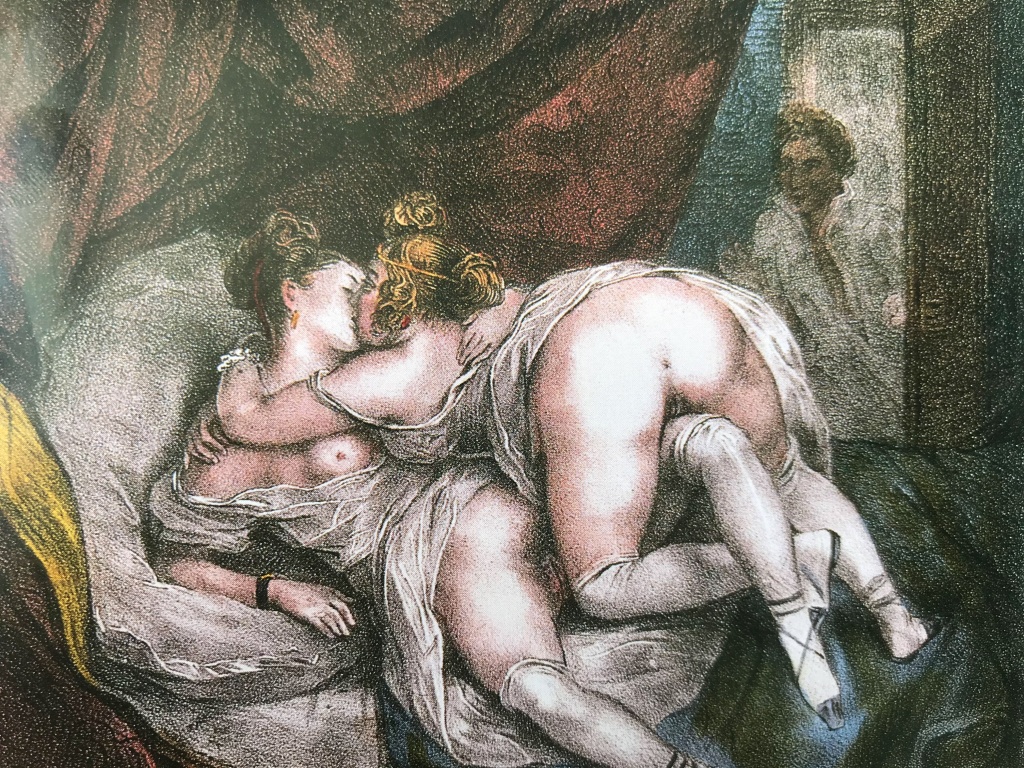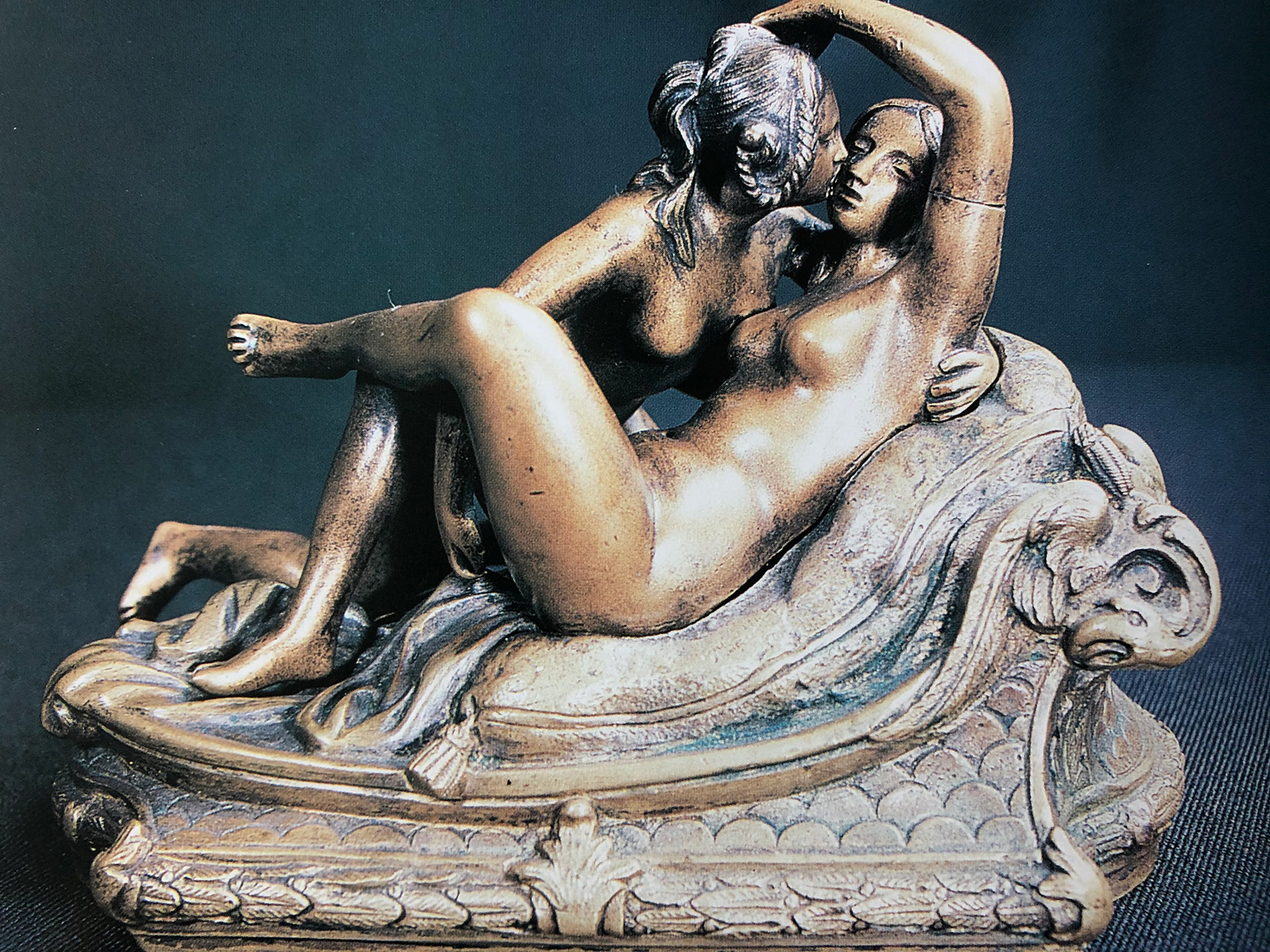Megan Brailey
During my internship in the Naomi Wilzig Art Collection project at Humboldt University, I became interested in writing about the representation of female same-sex sexuality in erotic art because of the way the artworks I encountered both reflected and refuted usual representations. After conducting some preliminary research, I realized how little I was able to articulate the intricacies of the representation and discrimination of lesbian women. In this blog post, I will discuss the production, representation, and categorization of lesbian erotic art. I will first address the general lack of self-authored lesbian art, then the perception of lesbian sexuality, and thirdly, the terminology that is used to talk about female same-sex sexuality in art history. When I refer to lesbian art in this blog post, I am referring to visual art, mostly paintings, and lithographs, depicting female same-sex sexuality and specifically the representation of lesbianism in erotic and sexually explicit art.
Representations of Explicit Female Same-Sex Sexuality: Erasure and Hyper-Sexualization
Women in general, and especially queer women, for a long time, did not have access to the arts and the means of artistic production. Systems of patriarchy and heteronormativity today often discriminate against homosexuals socially, culturally, and legally. Throughout history, convictions about what is normal and natural in relation to sexuality meant that heterosexuality was the norm and homosexuality was deemed sinful and a punishable crime or a pathological illness. Additionally, until the 20th century, women did not have the right to own property or control their wages[i] and didn’t have equal pay or rights to men[ii]. Therefore, it was not only difficult for lesbian women to produce art, but those representations were also either hidden or kept private, systematically destroyed, or presented in such a way by collectors and curators that negated any notion of lesbianism.
But lesbian erotic and sexually explicit art was difficult to produce not just because homosexuality was taboo but also because explicit sexual content, in general, was unacceptable in both the public and private view. Especially as for the most part of European art history the arts were sanctioned for and commissioned by the church and the aristocracy. Partially because of (queer) women’s difficulties accessing the arts, there are few historical examples of sexually explicit representations of female same-sex sexuality which were produced by queer female artists[iii][iv]. Additionally, it is often hard to identify erotic artworks by lesbian women because erotic art was often produced under a pseudonym, or the artists remained anonymous.
This erasure and lack of representations of female same-sex sexuality by lesbians are paradoxically accompanied by a hyper-sexualization and fetishization of lesbianism in erotic art and popular culture. As Jamie Jenkins shows in her analysis of the US Cold War period, anxieties about gender norms and sexuality caused moral panics whilst simultaneously, erotic lesbian fiction was mass-produced for a widely heterosexual male audience. This is in tandem with the commercialization of sex and women in advertising for consumer markets[v][vi].
Most of the representations of female same-sex sexuality in visual art were made by men for heterosexual men, which is why many scholars highlight that they conform to the heterosexual “male gaze”. The male gaze can be broadly defined as representing women from a heterosexual male perspective that usually regards women as sexual objects for the pleasure of the male viewer and so conforms to beauty standards set by heterosexual men. Meaning that, in the context of erotic art, most of the representations and terms we have for female same-sex sexuality are men’s ideas of what female sexuality looks like.[vii] This leads to misrepresentations of lesbian relationships and often hypersexualizes and heterosexualizes them, in the sense that lesbian sexual pleasure is seen as something intended for the pleasure of men rather than for the women involved. This relates to the patriarchal bias, wherein men are often seen as the “subjects” of sex, whilst women are often the “objects”[viii].
Representations of Female Same-Sex Sexuality in the Naomi Wilzig Collection
Of around 1600 artworks in the Naomi Wilzig collection that I reviewed, approximately 72 artworks depict representations of female same-sex sexuality.[ix]. Of these 72 artworks, 34 are sex scenes of female couples (image 1), 25 artworks show group sex scenes involving one man (or more) surrounded by more than two women, where the women were at times having sex with one another but are usually centered around the man (image 2); 5 artworks show group sex scenes involving only women; 6 artworks show lesbian sex scenes that include a male voyeur (image 4) whereas only 2 artworks depict lesbian sex scenes with a female spectator (image 3).




It is notable that there are almost as many group sex scenes involving multiple women as sex scenes showing just lesbian couples without a voyeur. I interpret this quantity of group sex scenes depicting female same-sex sexuality with a man involved and the ubiquity of depictions of female same-sex sexual intercourse with a male voyeur as an example of the hyper-sexualization of lesbianism for a male audience[x]. Most artworks were done by men, or the artist is unknown. Many artworks cater to what is acceptable to the heterosexual male gaze, and the majority of the women represented are white and feminine in appearance. Interestingly there is one painting in the section about female same-sex couples that depicts a nude woman on a sofa with what the description calls a “butch hairdo” (image 5). There are some other exceptions to the heteronormative framing of lesbian sexuality, such as the female voyeur in a lesbian sex scene (image 4) and, for example, a sex scene between three women and a trans* woman (image 5).


Interestingly, these exceptions, as well as the majority of the artworks showing lesbian sexuality I found, were from France from the 19th and 20th centuries. In France, especially during the decadent movement in Paris, lesbians were seen, despite being at the bottom of the social hierarchy along with sex workers, peasants, and bartenders, as representing “new models of sexual freedom.” “Lesbianism – both the identity and the term itself – became part of the French bohemian, artistic underground”[xi]. Therefore, these images do not necessarily represent a lack of bias in French culture at the time but highlight how representations of the deviation from the norm and social realism were in fashion. It is telling that two of the French artworks (images 3 and 6) are from books which also represent other taboo scenes such as zoophilia.
Titling and categorization
Art depicting female same-sex sexuality is often heterosexualized in the process of cataloging, meaning that potentially homoerotic content is described with neutral titles and descriptions in order to erase explicit references to lesbianism.[xii] Additionally, there is often a general inconsistency in the cataloging of erotic art because there is no clearly defined, specific terminology on sexuality in the arts. Whether and how the homoerotic content or subtext is recorded is, therefore, often dependent on the individual art historian or cataloguer. As in general society, there is a distinctive lack of non-biased terminology to speak about homosexuality in a non-heterosexualized way. Often when lesbian sexuality is addressed, it implies that any other sex than heterosexual vaginal sex isn’t “real” sex. See, for example, this mid-18th century French bronze statuette of two women on a chaise lounge, one leaning over the other as they engage in manual sex (image 7). The description in the catalogue reads: “two nude women embracing on a chaise”. Similarly, the description of another painting of a lesbian couple (image 8) states: “two women engaged in an erotic embrace”.


The phrase “erotic embrace” is incredibly vague because an embrace can be intimate but not sensual or erotic. But the sexual practices depicted in the artworks could more precisely be described as “groping,” “kissing,” “masturbation,” or “manual sex.” Likewise, lesbian sex scenes are frequently described as “sex play” or “sexual play” when women are engaging in explicitly sexual acts such as cunnilingus or fingering (image 9). The Collins English Dictionary defines sex play as: “erotic caressing”, “as a prelude to sexual intercourse, foreplay”.[xiii] Therefore, describing these depictions in this way trivializes sexual intercourse that is non-penetrative and non-heterosexual. This can be understood as projecting heteronormative expectations of sexual intercourse unto representations of female same-sex sexuality. I would propose that less veiled and more precise language is necessary to describe lesbian sexuality.

Final thoughts
Whilst writing this article, I felt myself lacking the vocabulary that is necessary to describe the intricacies of discrimination against lesbian women under systems of patriarchy and homophobia in capitalistic systems, which benefit from both. Although most of the representations of lesbian sexuality in the Naomi Wilzig collection conform to heteronormative and hypersexualizing norms, it’s worth mentioning that the fact that the collection even contains any exemptions from this norm at all is impressive if we consider the Western art historical canon. I am still spurred to research more and feel the overwhelming desire to promote more lesbian and queer artists in general and to create and distribute more representations of female same-sex sexuality. The more diverse images of female same-sex sexuality there are from a wide range of sources – importantly also from women representative of this group – the more representative collections such as the Naomi Wilzig collection will be of the diverse and varied sexualities and sexual practices of lesbian women. This is not only important in order to counter the erasure but also because, in my opinion, there is a link between the portrayal of lesbianism in art and the day-to-day treatment of lesbian women today.
A contemporary artist who combats many of the issues I have described, who prefers to call themselves a visual activist rather than a visual artist, is Zanele Muholi. They state that: “most of the work I have done over the years focuses exclusively on black LGBTQIA and gender-nonconforming individuals, making sure we exist in the visual archive”[xiv]. In their art, I see important themes of self-authorship and reflection, activism, and the necessity of representation. You can find more information about them here: https://www.dailyartmagazine.com/black-artists-matter/
[i] The Harvard Business School, ‘Women, Enterprise & Society’. Women and The Law. https://www.library.hbs.edu/hc/wes/collections/women_law/. 2010 [ii] Gert Hekma: A Cultural History of Sexuality in the Modern Age. Introduction. Berg Publishers. 2012. [iii] Ellen Oredsson: Lesbianism and Queer Women in Art History: Where Are They? http://www.howtotalkaboutarthistory.com/reader-questions/lesbianism-sex-female-desire-art-history/ 5. September 2016. [iv] At the end of the 20th century and in the 21st century, this has started to change also due to the democratization of the arts, with art supplies becoming cheaper and the internet meaning that people can propagate their art without galleries and other institutions. [v]Jamie Jenkins: Fear or Fetish? The Fetishisation of Lesbians in Cold War America. http://www.historymatters.group.shef.ac.uk/fear-or-fetish/ 20. January 2021. [vi] See, for example, Tom Reichert: The Erotic History of Advertising. Prometheus Books. 2003. For an excerpt, see https://aef.com/classroom-resources/book-excerpts/erotic-history-advertising/. [vii] Ellen Oredsson: Lesbianism and Queer Women in Art History: Where Are They? [viii] Gert Hekma: A Cultural History of Sexuality in the Modern Age. [ix] I say approximately, as I could only work with images of the art objects and not the objects themselves, and some depictions are ambiguous and unclear, and others are still uncatalogued. [x] See Jenkins for more on the hyper-sexualization of lesbianism and the idea of lesbians as nymphomaniacs. [xi] Ellen Oredsson: Lesbianism and Queer Women in Art History: Where Are They? [xii] How to Talk About Art History Blog [xiii] https://www.collinsdictionary.com/dictionary/english/sex-play [xiv] https://www.dailyartmagazine.com/black-artists-matter/
Megan Brailey is currently completing her B.A. in English literature at Durham University, UK, after studying a year abroad at Humboldt University, Berlin.



